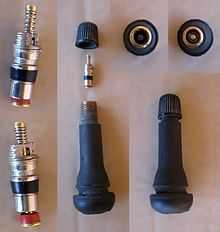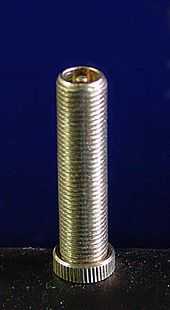Schrader valve




The Schrader valve (also called American valve[1]) is a brand of pneumatic tire valve used on virtually every motor vehicle in the world today. The Schrader company, for which it was named, was founded in 1844 by August Schrader. The original Schrader valve design was patented in the United States in 1893.
The Schrader valve consists of a valve stem into which a valve core is threaded, and is used on virtually all automobile tires and motorcycle tires and most wider rimmed bicycle tires. The valve core is a poppet valve assisted by a spring.
Uses
In addition to tube and tubeless tires, Schrader valves of varying diameters are used on many refrigeration and air conditioning systems to allow servicing, including recharging with refrigerant; by plumbers conducting leak-down pressure tests on pipe installations; as a bleeding and test port on the fuel rail of some fuel injected engines; on bicycle air shock absorbers to allow adjustment of air pressure according to riders weight; and in the buoyancy compensator (BC) inflators of SCUBA systems where the ability to easily disconnect an air hose (even underwater) without the loss of tank air is critical. Schrader valves are also widely used in high-pressure hydraulic systems on aircraft.[citation needed] Many domestic fire extinguishers use an internal valve identical to a Schrader valve, but with a lever on top to enable quick release of the pressurized content.
Valve
A Schrader valve consists of an externally threaded hollow cylindrical metal tube, typically of brass. In the center of the exterior end is a metal pin pointing along the axis of the tube; the pin's end is approximately flush with the end of the valve body.
Generally, all Schrader valves used on tires have threads and bodies of a single standard size at the exterior end, so caps and tools generally are universal for the valves on all common applications. The core of the valve can be removed or tightened with a tool.
A new development is Schrader valve stems with integrated transmitters for tire pressure monitoring systems (TPMS).
Cap
A valve cap is important on a Schrader valve because if one is not fitted, dirt and water can enter the outside of the valve, potentially jamming it or contaminating the sealing surfaces and causing a leak. Rock salt and other chemical de-icers used in the winter are especially damaging for the brass components in the Schrader valve.[citation needed]
Some valve caps have a rubber-washer seal (or a synthetic-rubber-washer seal) inside to help make a hermetic seal (airtight seal). Such a rubber-washer-sealing-type cap also helps prevent air from escaping from a slightly leaking valve. In addition, the rubber washer prevents the cap from loosening and falling off due to vibrations and hence being lost, by acting as a cushion between the cap and the valve stem and in this way damping the vibrations. The caps without these rubber-washer seals inside them effectively serve mostly to keep contaminants out of the valve stem, without providing a good hermetic seal. The caps without rubber washers inside them can also loosen and fall off due to vibrations when undertightened, especially if they are made of hard plastic or hard-plastic-lined metal. Valve caps are mostly made of black plastic and also of metal or plastic-lined metal, with rubber washers found inside some caps made of plastic and most metal caps. However, to prevent corrosion due to electrolysis and malfunction of the electronics in a direct TPMS (tire-pressure-monitoring system) and avoid costly repairs, metal valve caps without insulating plastic linings should never be used on direct-TPMS-equipped tire valve stems.[citation needed] Therefore, only plastic caps or metal caps with plastic linings should be used in direct-TPMS-equipped tire valve stems. Moreover, metal valve caps without plastic linings can also cause corrosion and may become stuck to the valve and require breaking of the valve in order to remove it when the cap metal (such as brass) is different than the valve metal (such as aluminium). When the valve caps are installed, care must be made not to leave them loose, as they may not seal properly and may even come loose and fall off. Overtightening the valve caps might damage the rubber washer inside the cap, damage or break the cap itself, or damage the valve. Also, installing the cap at a slight angle can cause stripping of the threads and, therefore, it should be gently finger-tightened while ensuring that it is straight and the threads aren't stripped.[citation needed]
There are also special pressure monitoring valve caps available that use a spring-loaded piston to raise a green flag when the pressure is at or above the correct setting. Upon losing pressure the green flag is retracted to reveal a red pin, hopefully catching the attention of the owner before fuel is wasted or safety is compromised by running the tire under-inflated.[citation needed]
Recently, colored plastic valve caps have appeared. Certain automobile tire dealerships are promoting the use of dry nitrogen to inflate tires. Dealers claim that eliminating oxygen and water will prolong the life of both tires and wheels. These dealers install green caps to signify that the tires are filled with nearly pure (typically about 95%) nitrogen. In contrast, regular air is approximately 78% nitrogen. The moisture in the air-filled tires condenses in below-freezing temperatures and causes a sudden drop in tire pressure. Dry-nitrogen filling helps prevent this problem. As an alternative to green nitrogen-ID (nitrogen-identification) caps, green nitrogen-ID O-rings to be installed on valve stems under the caps, while still using black- or metallic-colored caps, are also available.[citation needed]
Other vendors sell caps in a variety of other colors for purely decorative purposes, including (usually battery-powered) caps that light up when the wheels move. When used on a bicycle, the illuminated type are claimed (by the manufacturers) to enhance night-time and twilight rider safety by improving their visibility to other road users.
Presta valves vs. Schrader valves
Whereas Schrader valves are almost universal on car tires, bicycle tubes have Dunlop, Schrader or Presta valves. Both the Schrader and the Presta types are good at sealing high pressures. Their chief differences are that Schrader valves are larger and have springs that close the valve except when the pin is depressed. Schrader valves are used in a wide variety of compressed gas and pressurized liquid applications.[citation needed]
Presta valve stems are 6 mm diameter, whereas Schrader valve stems for bicycle tires are 8 mm, thus requiring a larger diameter hole in a bicycle rim. While not a concern on wider bike rims, it will weaken a narrow wheel rim, precluding their use on (road) racing bicycles. Another disadvantage of the Schrader is that the air chuck must depress the spring-loaded pin before air can flow during inflation, whereas the Presta valve relies solely on internal air pressure to keep it shut. This means that some air is lost while attaching and detaching pumps to Schrader valves, although this is usually nominal (most of the air which makes the "whooshing" noise when the pump is removed comes from the compressed air in the tube between the pump body and the attachment end, not the tire via the momentarily-open Schrader valve). To fill up a bicycle tire with a Presta-valved tube at a gas station requires an adaptor, while a Schrader-valved tube does not.
Dimensions
Schrader valves are classified by their material, diameter of intended rim hole, length, and shape.
- TR-4 - straight metal stem (8 mm dia.)
- TR-6 - straight metal stem (8 mm dia.)
- TR-13 - straight rubber stem (11.5 mm dia.)
- TR-15 - straight rubber stem (16 mm dia.)
- TR-87 - short 90° metal stem (10 mm dia.)
- TR-87C - tall 90° metal stem (10 mm dia.)
and also :
- TR 413- 0.453" rim hole diam.(11.50 mm) 1.25" long (=31.8 mm)
- TR 415- 0.625" rim hole diam.(15.87 mm) 1.25" long (=31.8 mm)
- TR 418- 0.453" rim hole diam.(11.50 mm) 2" long (=50.8 mm)
- TR 425- 0.625" rim hole diam.(15.87 mm) 2" long (=50.8 mm)
The standard Schrader valve has the following threads:
External thread
- Metric: 7.7 mm OD, thread root diameter is 6.9 mm × 0.794 mm pitch.
- Imperial: 0.305 in OD, thread root diameter 0.271 in × 32 tpi (threads per inch)
Internal thread (to accept the threaded valve core)
- Metric: 5.30 mm OD × 0.706 mm pitch
- Imperial: 0.209 in OD × 36 tpi.
For refrigeration, a 1/4" male flare fitting is used, with the same internal thread as above.
See also
- Presta valve
- Valve stem
- Dunlop valve also called a Woods valve or an English valve
- Schrader Valve
References
- ↑ Tony Atkins and Marcel Escudier (25 April 2013). A Dictionary of Mechanical Engineering. Oxford University Press. p. 312. ISBN 9780199587438. Retrieved 23 October 2013.
http://www.schraderinternational.com
External links
| Wikimedia Commons has media related to Schrader valve. |